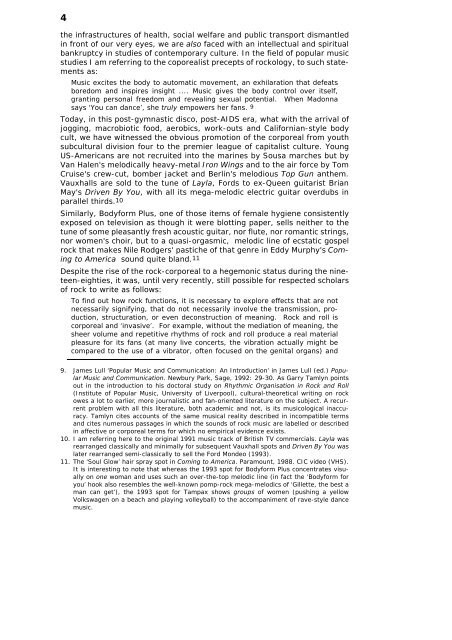From Refrain to Rave - Philip Tagg's home page
From Refrain to Rave - Philip Tagg's home page
From Refrain to Rave - Philip Tagg's home page
Create successful ePaper yourself
Turn your PDF publications into a flip-book with our unique Google optimized e-Paper software.
4<br />
the infrastructures of health, social welfare and public transport dismantled<br />
in front of our very eyes, we are also faced with an intellectual and spiritual<br />
bankruptcy in studies of contemporary culture. In the field of popular music<br />
studies I am referring <strong>to</strong> the coporealist precepts of rockology, <strong>to</strong> such statements<br />
as:<br />
Music excites the body <strong>to</strong> au<strong>to</strong>matic movement, an exhilaration that defeats<br />
boredom and inspires insight .... Music gives the body control over itself,<br />
granting personal freedom and revealing sexual potential. When Madonna<br />
says ‘You can dance’, she truly empowers her fans. 9<br />
Today, in this post-gymnastic disco, post-AIDS era, what with the arrival of<br />
jogging, macrobiotic food, aerobics, work-outs and Californian-style body<br />
cult, we have witnessed the obvious promotion of the corporeal from youth<br />
subcultural division four <strong>to</strong> the premier league of capitalist culture. Young<br />
US-Americans are not recruited in<strong>to</strong> the marines by Sousa marches but by<br />
Van Halen's melodically heavy-metal Iron Wings and <strong>to</strong> the air force by Tom<br />
Cruise's crew-cut, bomber jacket and Berlin's melodious Top Gun anthem.<br />
Vauxhalls are sold <strong>to</strong> the tune of Layla, Fords <strong>to</strong> ex-Queen guitarist Brian<br />
May's Driven By You, with all its mega-melodic electric guitar overdubs in<br />
parallel thirds.10<br />
Similarly, Bodyform Plus, one of those items of female hygiene consistently<br />
exposed on television as though it were blotting paper, sells neither <strong>to</strong> the<br />
tune of some pleasantly fresh acoustic guitar, nor flute, nor romantic strings,<br />
nor women's choir, but <strong>to</strong> a quasi-orgasmic, melodic line of ecstatic gospel<br />
rock that makes Nile Rodgers' pastiche of that genre in Eddy Murphy's Coming<br />
<strong>to</strong> America sound quite bland.11<br />
Despite the rise of the rock-corporeal <strong>to</strong> a hegemonic status during the nineteen-eighties,<br />
it was, until very recently, still possible for respected scholars<br />
of rock <strong>to</strong> write as follows:<br />
To find out how rock functions, it is necessary <strong>to</strong> explore effects that are not<br />
necessarily signifying, that do not necessarily involve the transmission, production,<br />
structuration, or even deconstruction of meaning. Rock and roll is<br />
corporeal and ‘invasive’. For example, without the mediation of meaning, the<br />
sheer volume and repetitive rhythms of rock and roll produce a real material<br />
pleasure for its fans (at many live concerts, the vibration actually might be<br />
compared <strong>to</strong> the use of a vibra<strong>to</strong>r, often focused on the genital organs) and<br />
9. James Lull ‘Popular Music and Communication: An Introduction’ in James Lull (ed.) Popular<br />
Music and Communication. Newbury Park, Sage, 1992: 29-30. As Garry Tamlyn points<br />
out in the introduction <strong>to</strong> his doc<strong>to</strong>ral study on Rhythmic Organisation in Rock and Roll<br />
(Institute of Popular Music, University of Liverpool), cultural-theoretical writing on rock<br />
owes a lot <strong>to</strong> earlier, more journalistic and fan-oriented literature on the subject. A recurrent<br />
problem with all this literature, both academic and not, is its musicological inaccuracy.<br />
Tamlyn cites accounts of the same musical reality described in incompatible terms<br />
and cites numerous passages in which the sounds of rock music are labelled or described<br />
in affective or corporeal terms for which no empirical evidence exists.<br />
10. I am referring here <strong>to</strong> the original 1991 music track of British TV commercials. Layla was<br />
rearranged classically and minimally for subsequent Vauxhall spots and Driven By You was<br />
later rearranged semi-classically <strong>to</strong> sell the Ford Mondeo (1993).<br />
11. The ‘Soul Glow’ hair spray spot in Coming <strong>to</strong> America. Paramount, 1988. CIC video (VHS).<br />
It is interesting <strong>to</strong> note that whereas the 1993 spot for Bodyform Plus concentrates visually<br />
on one woman and uses such an over-the-<strong>to</strong>p melodic line (in fact the ‘Bodyform for<br />
you’ hook also resembles the well-known pomp-rock mega-melodics of ‘Gillette, the best a<br />
man can get’), the 1993 spot for Tampax shows groups of women (pushing a yellow<br />
Volkswagen on a beach and playing volleyball) <strong>to</strong> the accompaniment of rave-style dance<br />
music.














